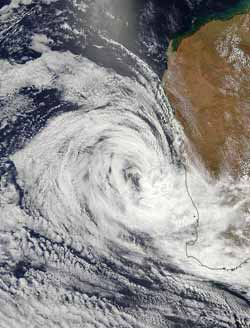NASA satellites see wind shear battering Tropical Depression Iggy

NASA's Aqua satellite passed over Tropical Cyclone Iggy on Feb. 2, 2012 at 0615 UTC (1:15 a.m. EST). The Moderate Resolution Imaging Spectroradiometer (MODIS) instrument captured a true color image of the storm. In the image, Iggy appears elongated from northwest to southeast, which is the direction of the wind shear. Credit: NASA Goddard MODIS Rapid Response Team<br>
NASA infrared satellite imagery showed that Iggy's strongest thunderstorms have been pushed away from the storm's center and visible imagery shows the storm is being stretched out. Iggy is weakening and heading for a landfall between Geraldton and Perth.
When NASA's Aqua satellite passed over Tropical Cyclone Iggy on Feb. 1 at 1805 UTC (1:05 p.m. EST), the Atmospheric Infrared Sounder (AIRS) instrument aboard captured an infrared look at the cyclone. AIRS data showed that the strongest thunderstorms (with the coldest cloud top temperatures) had been pushed to the southeast of Iggy's center. That convection was pushed by vertical wind shear from the northwest. Once convection is pushed away from a tropical cyclone's center, the storm begins to fall apart. Tropical cyclones must be stacked in the atmosphere like a haystack. If the middle (convection in this case) gets pushed out, then the storm collapses.
The Moderate Resolution Imaging Spectroradiometer (MODIS) instrument aboard NASA's Aqua satellite captured a true color image of Iggy when it passed overhead on Feb. 2, 2012 at 0615 UTC (1:15 a.m. EST). The MODIS image clearly shows how the wind shear is affecting the tropical depression because Iggy appears elongated from northwest to southeast, which is the direction of the wind shear.
The Australian Bureau of Meteorology (ABM) issued severe weather warnings for residents from Kalbarri to Morawa, and from Morawa to Wongan Hills; and Wongan to Narrogin and Harvey. The ABM website noted that the warning includes people in, near or between the following towns: Geraldton, Jurien Bay, Perth, Mandurah, York and Narrogin. Those areas can expect thunderstorms with heavy rainfall, and gusty winds as Iggy continues moving east. Flash flooding is also a possibility from the heavy rainfall.
On February 2, 2012, Tropical Depression Iggy had maximum sustained winds near 30 knots (~35 mph/~56 kph). It was located about 170 nautical miles (~196 miles/~315 km) northwest of Perth, Western Australia, and its center was near 29.9 South latitude and 114.2 East longitude. Iggy was moving to the east at 14 knots (16 mph/~26 kph) and is expected to continue in that direction making landfall before 0300 UTC on February 3, 2012 (or before 10 p.m. EST, Feb. 3). Iggy is expected to quickly weaken to a remnant low as it moves further inland in Western Australia.
Media Contact
More Information:
http://www.nasa.govAll latest news from the category: Earth Sciences
Earth Sciences (also referred to as Geosciences), which deals with basic issues surrounding our planet, plays a vital role in the area of energy and raw materials supply.
Earth Sciences comprises subjects such as geology, geography, geological informatics, paleontology, mineralogy, petrography, crystallography, geophysics, geodesy, glaciology, cartography, photogrammetry, meteorology and seismology, early-warning systems, earthquake research and polar research.
Newest articles

Bringing bio-inspired robots to life
Nebraska researcher Eric Markvicka gets NSF CAREER Award to pursue manufacture of novel materials for soft robotics and stretchable electronics. Engineers are increasingly eager to develop robots that mimic the…

Bella moths use poison to attract mates
Scientists are closer to finding out how. Pyrrolizidine alkaloids are as bitter and toxic as they are hard to pronounce. They’re produced by several different types of plants and are…

AI tool creates ‘synthetic’ images of cells
…for enhanced microscopy analysis. Observing individual cells through microscopes can reveal a range of important cell biological phenomena that frequently play a role in human diseases, but the process of…





















